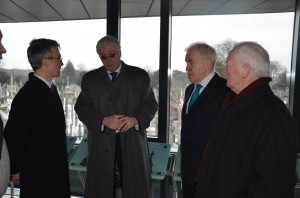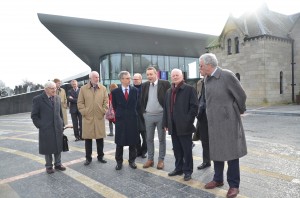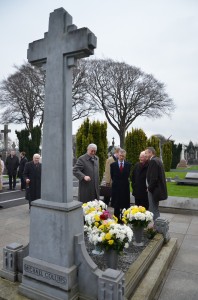

 This afternoon I attended a lunch at Glasnevin Cemetery and Museum in honour of the visit of Dr Andrew Murrison MP, British Minister for International Security Strategy in the Ministry of Defence, given by Jimmy Deenihan TD, Irish Minister for Arts, Heritage and the Gaeltacht. The lunch was also attended by the British Ambassador to Ireland, Dominick Chilcott, Dinny McGinley TD Irish Minister of State with responsibility for Gaeltacht and the Islands and senior British and Irish Officials.
This afternoon I attended a lunch at Glasnevin Cemetery and Museum in honour of the visit of Dr Andrew Murrison MP, British Minister for International Security Strategy in the Ministry of Defence, given by Jimmy Deenihan TD, Irish Minister for Arts, Heritage and the Gaeltacht. The lunch was also attended by the British Ambassador to Ireland, Dominick Chilcott, Dinny McGinley TD Irish Minister of State with responsibility for Gaeltacht and the Islands and senior British and Irish Officials.
I attended as Advisor on History and Culture to Rev Dr Ian Paisley, The Lord Bannside and Baroness Paisley, with whom I had previously visited the Cemetery and Museum, as well as Chairman of the Somme Association . Sitting with John Kennedy, his colleague George McCullough spoke of the UVF man buried in the Republican plot in Glasnevin Cemetery. He has sent me the following report from Shane MacThomais.
Now they say politics makes strange bedfellows but in my mind graveyards make the strangest bedfellows of them all. Such is the case of Richard Simpson, a Belfast Loyalist who signed the Ulster Covenant and ended up being buried side by side with Irish Volunteers and members of the Irish Citizen Army in the Republican plot in Glasnevin Cemetery.
Richard Simpson was born in Belfast in 1877, Presbyterian in faith he married Ann Jane Briggs in St Anne’s Church in 1900 and lived in Oregon Street Belfast. They had three children, Effra, Ann Jane and Robina. Richard earned his living as a casual labourer.
In 1912 as a protest against the Third Home Rule Bill, Sir Edward Carson drafted The Ulster Covenant, which asked people to “defeat the present conspiracy to set up a Home Rule Parliament in Ireland”. On the 28 September 1912, 471,414 men and women across Ireland followed Edward Carson, the first signatory, and declared their resistance to any form of Irish Independence. Richard Simpson was one of these. One year later when the Ulster Volunteer Force was founded Richard, as a signatory of the covenant became a member.
When World War One broke out 90,000 members of the UVF joined the British army and made up the 36th (Ulster) Division. Richard Simpson followed these into the army when he enlisted into the Royal Irish Regiment in Belfast on the 12th April 1915. A month later due to him being unfit for overseas service Rifleman Simpson was assigned to the 18th Battalion (reserve) of the regiment. As his comrades from the UVF were fighting in France, Richard was transferred to the Royal Irish Fusiliers in Wellington Barracks (Now Griffith College) Dublin on the 31st March 1916.
Two days before the 1916 Rebellion was to start, on the 22nd April 1916, three soldiers entered into a room in Wellington barracks. They were later to testify that on entering they could smell a strong smell of gas. In the room they found the motionless body of Richard Simpson. A coroner’s inquest was ordered and the body was placed in the barracks morgue. The coroner’s inquest was never to take place. As the city burned with the flames of insurrection the body of the rifleman from Belfast was simply forgotten about.
During the Easter Rebellion, General Maxwell had declared marital law and no funerals took place. The bodies of those killed during the Rising were wrapped in canvas and held in Dublin Castle. Some were temporarily buried but most were laid out in the Upper Square. On the 1st May, with the rebellion over, the first funerals were allowed and over 250 corpses were transported across shell-shocked city to Glasnevin Cemetery. Amongst these was placed the remains of Rifleman Simpson.
In Glasnevin a trench had been dug in the St Paul’s section of the cemetery. It was eight graves wide and thirty graves long. Into this trench was placed the remains of the Irish Volunteers, and Citizen Army who had fallen in battle for the Republic and with them wearing the uniform of a British soldier is the mortal remains of a proud member of the UVF.